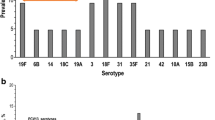Abstract
In a prospective clinical study, rates of isolation ofMoraxella catarrhalis in nasopharyngeal aspirates from 122 children with respiratory tract infection and 72 healthy controls were compared. In the patient group,Moraxella catarrhalis andStreptococcus pneumoniae were the most frequently isolated pathogens (38% and 42%, respectively). Monocultures of each pathogen were equally distributed in patients and controls (41% vs. 42%), whereas mixed infections were found more frequently in the patient group (42% vs. 14%; normal flora, 17% vs. 44%).Moraxella catarrhalis appears to be a relevant respiratory pathogen. The isolation of two or more pathogens in nasopharyngeal aspirates seems to be as indicative of relevant infection as is monoculture.
Similar content being viewed by others
References
Catlin BW:Branhamella catarrhalis: an organism gaining respect as a pathogen. Clinical Microbiology Reviews 1990, 3: 293–320.
Nicotra B, Rivera M, Luman JI, Wallace RJ Jr:Branhamella catarrhalis as a lower respiratory tract pathogen in patients with chronic lung disease. Archives of Internal Medicine 1986, 146: 890–893.
Jousimies-Somer HR, Savolainen S, Ylikoski JS: Comparison of the nasal bacterial floras in two groups of healthy subjects and in patients with acute maxillary sinusitis. Journal of Clinical Microbiology 1988, 27: 2736–2743.
Mölstad S, Eliasson I, Hovelius B, Kamme C, Schalen C: Beta-lactamase production in upper respiratory tract flora in relation to antibiotic consumption: a study in children attending day nurseries. Scandinavian Journal of Infectious Diseases 1988, 20: 329–334.
Korppi M, Katila ML, Jääskeläinen L, Leinonen M: Role ofMoraxella (Branhamella) catarrhalis as a respiratory pathogen. Acta Paediatrica 1992, 81: 993–996.
Gottfarb P, Brauner A: Children with persistent cough — outcome with treatment and role ofMoraxella catarrhalis. Scandinavian Journal of Infectious Diseases 1994, 26: 545–551.
Darelid J, Löfgren S, Malmvall B-E: Erythromycin treatment is beneficial for longstandingMoraxella catarrhalis associated cough in children. Scandinavian Journal of Infectious Diseases 1993, 25: 323–329.
Morello JA, Janda WM, Doern GV:Neisseria andBranhamella. In: Balows A, Hausler WJ Jr, Herrmann KL, Isenberg HD, Shadomy HJ (ed): Manual of clinical microbiology. American Society for Microbiology, Washington, DC, 1991, p. 258–276.
Meurman O, Sarkkinen H, Ruuskanen O, Hänninen P, Halonen P: Diagnosis of RSV infection in children: comparison of viral antigen detection and serology, Journal of Medical Virology 1984, 14: 61–65.
National Committee for Clinical Laboratory Standards. Performance standards for antimicrobial disk susceptibility tests. Approved standard M2-A4. NCCLS, Villanova, PA, 1990.
Stenfors LE, Raisanen S: Interaction betweenStreptococcus pneumoniae andBranhamella catarrhalis obtained from double-colonized, healthy nasopharynx and double-infected, diseased middle ear cavity. Scandinavian Journal of Infectious Diseases 1989, 21: 397–401.
Goldblatt D, Turner MW, Levinsky RJ:Branhamella catarrhalis: antigenic determinants and the development of the IgG subclass response in childhood. Journal of Infectious Diseases 1990, 162: 1128–1135.
Doern GV, Tubert TA: Disk diffusion susceptibility testing ofBranhamella catarrhalis with ampicillin and seven other antimicrobial agents. Antimicrobial Agents and Chemotherapy 1987, 31: 1519–1523.
Author information
Authors and Affiliations
Rights and permissions
About this article
Cite this article
Berner, R., Schumacher, R.F., Brandis, M. et al. Colonization and infection withMoraxella catarrhalis in childhood. Eur. J. Clin. Microbiol. Infect. Dis. 15, 506–509 (1996). https://doi.org/10.1007/BF01691320
Issue Date:
DOI: https://doi.org/10.1007/BF01691320



